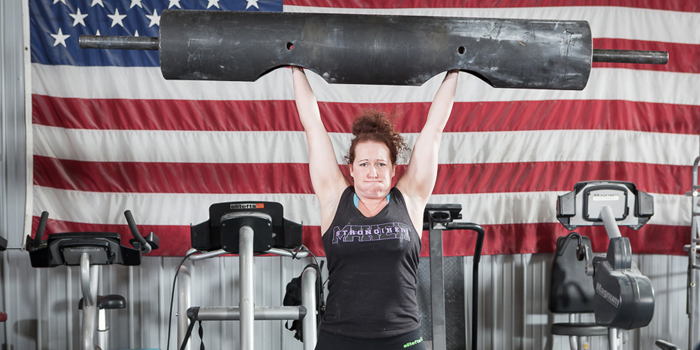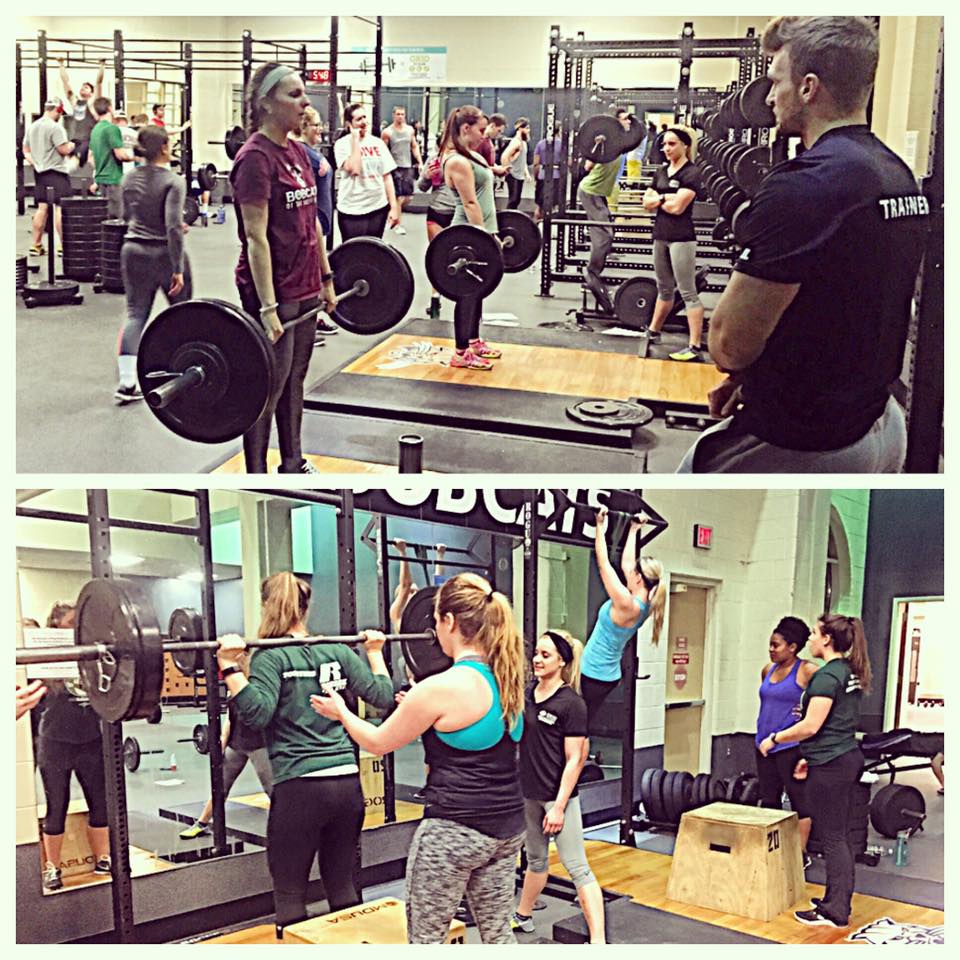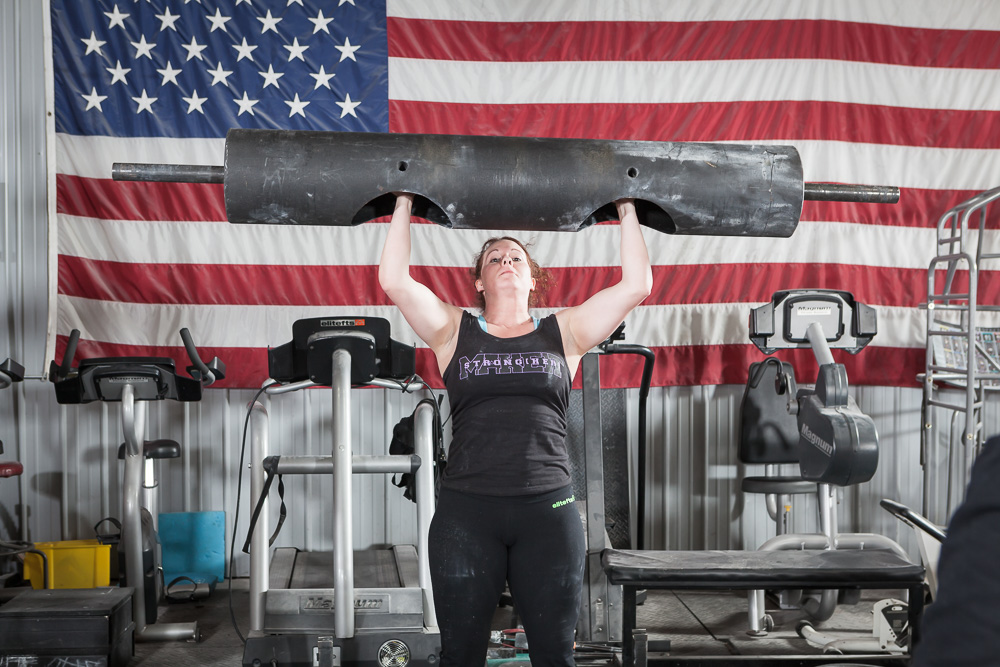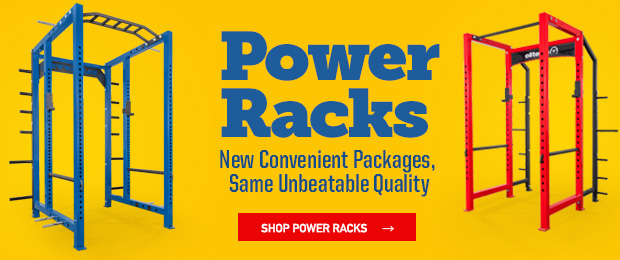
There are few movements as empowering as taking a heavy barbell and lifting it over your head. In the BarBelles Women’s Strength Training Program at Ohio University, we taught participants the standing overhead press, along with the squat, bench press, and deadlift. Along with deadlift, overhead press was the lift that the 35 female college students identified as having the least knowledge/experience performing. Ironically, this lift was also the one that the girls were able to pick up the quickest. This might have been due to the fact that they didn’t have any bad habits to break (as opposed to the squat, where many of them had been taught incorrect technique for years). As long as technique is taught correctly and the lifters are encouraged to be patient as they get accustomed to the movement, this lift is a great one to accompany the “big three” (squat, bench, and deadlift) when teaching barbell movements to beginners.
Like with the other barbell movements, we emphasized the importance of having the groups spot each other and provide coaching cues as they got more comfortable performing the overhead press. Especially from a side view, training partners could see and correct aspects of the setup like elbow positioning, and cue things during the movement like “head through” (we’ll go more into these cues later in the article).
RECENT: Strong(her) Squat Progressions for the Novice Female Lifter
Before having the girls work with the barbell, we did a full body dynamic warm-up followed by some practice reps with the PVC pipe to teach the bar path for those who were initially intimidated with putting the barbell overhead. We didn’t have the lifters do more than a few sets with the PVC pipe, because of the technique differences when using actual weight. Most of the lifters didn’t need to practice using the PVC pipe at the beginning of a workout for more than a session or two.
For a good portion of the girls who were very new to lifting, performing a strict overhead press would’ve been very difficult even with the empty barbell. We decided to teach the push press initially, then work on the strict press once they were comfortable performing the first movement. In order to teach the push press, we began with the following instructions regarding setup:
- Set the rack height so that the barbell is at lower chest level.
- Approach the barbell and grip the bar at about shoulder width.
- Set the feet directly underneath the bar and dip the hips down, bringing the elbows directly underneath the bar and flaring the lats (creating a “shelf” with the lats).
- Squat the bar up while keeping the lats and abs tight.
- Step back with the barbell, setting the feet at deadlift-stance width.
- “Stand proud” with the barbell, with the lats, abs, and glutes tight, and the chest up with the elbows directly underneath the wrists.
While some of these setup cues seem simple, if the setup isn’t done correctly, the rest of the lift will be next to impossible, especially with the overhead press. If the lifter sets up loosely with the elbows sitting too far back and the chest is dropped forward, the bar path will be thrown off and too much pressure will be put on the shoulders. We constantly re-iterated to the lifters that “how you start is how you will finish”, and how important the setup is.
RECENT: Strong(her) Bench Press Progressions for the Novice Female Lifter
Following a good setup, we taught the rest of the execution of the overhead press:
- With the chest up, lats and abs tight, and elbows under the bar; push the butt back and dip the hips down with the weight in the heels.
- As you drive the hips back through and stand up, drive the elbows up under the bar and squeeze the glutes to provide momentum from the top of the chest.
- As the bar passes in front of your face and over your head, push your head forward underneath the bar as you extend the elbows, so that way at the end position the barbell is directly over the top of the head (in line with your ears).
- To return to the starting position, push the butt back and dip the hips back down as you return the bar to the top of the chest with your elbows underneath, and stand back up as taught in the setup.
After teaching the basic technique for the push press, we had the girls perform three to five reps for multiple sets with the empty barbell, and then take small weight jumps while dropping the reps to two to three in order to get multiple sets of practice. Like I mentioned in my Strong(her) Bench Press Progressions article, keep in mind that even small weight jumps (two and a half or five-pound plates) can be large percentages of a one-rep max if the absolute strength of the lifter isn’t very high (initially, at least). Take small jumps when initially teaching the movement, and be aware that especially with a quickly fatiguing movement like overhead press, keeping the reps low will be important so you can get as much work in as possible the first few sessions.
The majority of the BarBelles lifters encountered the same issues when initially performing the movement:
Overextending the Back in an Effort to Press the Bar Overhead
The Cause: Some of the females were already naturally lordodic (lots of arch in the low back), and if they didn’t make an effort to keep a neutral spine and squeeze the glutes during the press, they would end up hyperextending the back and leaning backwards as they tried to press.
RECENT: Strong(her) Deadlift Progressions for the Novice Female Lifter
The Fix: Squeeze the glutes and abs tight during the press and push the head through underneath the bar as it moves past the face.
Failing the Lift Right in Front of the Face
The Cause: For the lifters that got fast drive off the chest but then died out right in front of the face, chances are they were letting the bar get too far in front of them (usually in fear of hitting themselves in the face). If the bar is out in front of the lifter’s center of gravity and the elbows aren’t underneath the bar, there will be no power to press the it overhead.
The Fix: Cue “head through” and make sure the bar is being pressed as close to the center line of the body as possible, and as soon as the bar is past the face make sure it is pressed back over head. A PVC pipe can be held in front of the lifter with the instructions not to hit the PVC with the bar, in an effort to help them keep the bar close to their body. Practicing good technique with light weights, and doing strict presses can help re-enforce this as well.
Going from Fast to Fail in One Lift
The Cause: For many of the lifters, one set would be fast for several reps, but as soon as a “big” plate was added to the bar (even if it was only a five-pound increase), they could not even get the bar off their chest. This was typically a mental block from when the lifter felt that the weight was heavy (even if it wasn’t relative to their strength). In many cases, when the weight felt heavy their setup would showcase their lack of confidence, and they would begin loose, with the chest low and bar collapsed without the elbows underneath.
The Fix: Using the “stand proud” cue at setup, making sure the elbows are under the bar and everything is tight, and being quick with the dip and drive can all help fix this problem. Strong, confident setup will translate to a strong lift.
These are some basic teaching tools to help you coach beginners on the overhead press. There are many more things that can be addressed with this movement, but this is a good place to start when working with the absolute beginner. In future articles I will discuss programming and how we implemented these newly-learned movements into a regular training program.













1 Comment